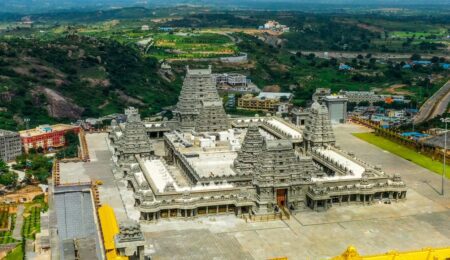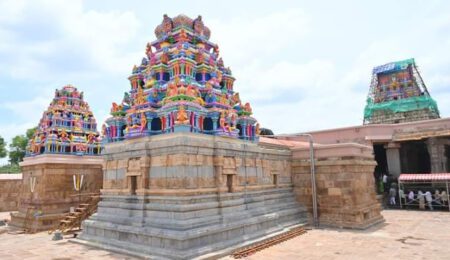Temple at Pattadakal: A Timeless Symphony of Chalukya Architecture
Introduction of Temple at Pattadakal: Where Stones Whisper Stories.
Nestled on the banks of the Malaprabha River in northern Karnataka lies the Temple at Pattadakal, a breathtaking ensemble of ancient shrines that echo the grandeur of the Chalukya dynasty. Designated as one of the UNESCO World Heritage Sites in Karnataka, Pattadakal is not just a cluster of temples it’s a living museum of art, architecture, and spirituality.
The Pattadakal temples are a harmonious blend of Dravidian and Nagara styles, showcasing the architectural experimentation that flourished during the 7th and 8th centuries. Whether you’re a history buff, a spiritual seeker, or a curious traveler, Pattadakal offers a soul-stirring experience that transcends time.

Historical Significance: The Chalukyan Legacy
Pattadakal History and Significance
The name “Pattadakal” translates to “place of coronation,” and rightly so. This sacred site was the ceremonial capital of the Chalukyas of Badami, where kings were crowned and commemorated. Alongside Aihole and Badami, Pattadakal formed a triad of cultural and architectural innovation.
- Built between the 6th and 8th centuries CE
- Patronized by rulers like Vijayaditya, Vikramaditya II, and Kirtivarman II
- Served as a canvas for experimenting with temple styles
The temples reflect a period of religious tolerance, with shrines dedicated to Shaivism, Vaishnavism, and Jainism.
You are reading: Temple at Pattadakal

Architectural Marvels: A Gallery of Sacred Geometry
Virupaksha Temple Pattadakal
Built in 740 CE by Queen Lokamahadevi to honor her husband Vikramaditya II’s victory over the Pallavas, this temple is the crown jewel of Pattadakal.
- Dravidian style with a three-tiered vimana
- Intricate carvings of Ramayana, Mahabharata, and Bhagavata Purana
- A separate Nandi Mandapa and ambulatory path
Mallikarjuna Temple Pattadakal
Constructed by Queen Trailokyamahadevi, this temple mirrors Virupaksha in layout but is slightly smaller.
- Rich friezes depicting Mahishasuramardini, Krishna Leela, and royal scenes
- Hemispherical roof and beautifully carved pillars
Sangameshwara Temple
The oldest temple in the complex, built by King Vijayaditya.
- Pure Dravidian style
- Sculptures of Ugra Narasimha, Nataraja, and Shiva-Parvati
Galaganatha Temple Pattadakal
A Nagara-style temple with a curvilinear shikhara.
- Dedicated to Lord Shiva
- Features a black basalt Shivalinga and carvings of Gajalakshmi and Kubera

UNESCO World Heritage Status: Global Recognition
In 1987, the Temple at Pattadakal was inscribed as a UNESCO World Heritage Site for its:
- Unique blend of northern and southern Indian architectural styles
- Historical importance as a coronation site
- Artistic excellence and preservation of ancient traditions
UNESCO describes Pattadakal as “a harmonious blend of architectural forms from northern and southern India” and “an illustration of eclectic art at its height”.
Legends and Stories: Where Myth Meets Stone
The friezes and sculptures at Pattadakal are not mere decorations—they’re storytellers.
- Sita’s abduction by Ravana, Krishna lifting Govardhan, and Bhishma on the bed of arrows are vividly depicted.
- Local lore says the Malaprabha River, which flows northward here, is considered sacred—called Uttarvahini Ganga.
- The site was once known as Raktapura and Kisuvolal, meaning “valley of red soil.”

Visitor Information: Pattadakal Travel Guide
Best Time to Visit Pattadakal
- October to February: Pleasant weather, ideal for sightseeing
- February: Attend the Pattadakal Dance Festival (Chalukya Utsava)
Entry Fees and Timings
| Category | Fee |
|---|---|
| Indian Citizens | ₹35 |
| Foreign Tourists | ₹550 |
| Children <15 | Free |
| Camera Fee | ₹25–₹50 |
- Open daily: 9:00 AM – 5:00 PM
How to Reach Pattadakal
By Air
- Hubballi Airport – 130 km away
- Belgaum Airport – 165 km away
By Train
- Badami Railway Station – 17 km from Pattadakal
By Road
- Well-connected via Karnataka State Highway SH14
- Regular buses from Badami, Bijapur, and Hubli
Nearby Attractions: Extend Your Journey
Aihole
- Known as the “Cradle of Indian Temple Architecture”
- Over 100 temples including Durga Temple and Lad Khan Temple
Badami
- Famous for rock-cut cave temples
- Agastya Lake, Bhutanatha Temple, and Badami Fort
Mahakuta
- A serene temple complex with a sacred water tank
- Important Shaiva pilgrimage site
Travel Tips: Make the Most of Your Visit
- Carry water, sunscreen, and a hat—the site is open and sun-exposed.
- Hire a local guide to understand the stories behind each sculpture.
- Photography is allowed, but avoid flash near delicate carvings.
- Ideal trip duration: Half-day to full-day
- Stay in Badami for better accommodation options
What is the best time to visit Pattadakal?
October to February is ideal, especially during the Chalukya Utsava in February, which features classical dance performances and cultural exhibitions.
Is Pattadakal suitable for family travel?
Yes! The site is safe, well-maintained, and educational for children and adults alike. There’s ample space to walk, explore, and enjoy a picnic nearby.
Are guides available at Pattadakal?
Local guides are available at the entrance. Hiring one enhances your experience by revealing the stories behind each sculpture and temple.
Can I visit Pattadakal in a day?
Absolutely. A well-planned itinerary can cover Pattadakal, Aihole, and Badami in one day, though two days allow for a more relaxed experience.
Bonus Section: Suggested Itinerary for Pattadakal and Surroundings
Day 1
- Morning: Arrive in Badami, check-in
- Midday: Explore Badami cave temples and Agastya Lake
- Evening: Sunset at Bhutanatha Temple
Day 2
- Morning: Drive to Aihole, visit Durga Temple and museum
- Midday: Head to Pattadakal, explore temple complex with guide
- Evening: Return to Badami or continue to Mahakuta
Conclusion:
Why Every Traveler Should Visit Pattadakal
The Temple at Pattadakal is not just a destination it’s a revelation. It’s where art meets devotion, where history breathes through stone, and where every sculpture tells a story. Whether you’re tracing the footsteps of the Chalukyas or simply soaking in the serenity of the Malaprabha River, Pattadakal promises an experience that’s both humbling and inspiring.
So pack your bags, charge your camera, and let the Pattadakal temples whisper their ancient secrets to you.
Final Thoughts: A Journey into India’s Sacred Past
The Temple at Pattadakal is more than a historical site it’s a spiritual and artistic pilgrimage. It invites you to walk through centuries of devotion, craftsmanship, and royal legacy. Whether you’re documenting your journey for a blog, capturing it through a lens, or simply soaking in the silence of stone, Pattadakal leaves an indelible mark on your soul.
So if you’re crafting your next travel itinerary or curating content that blends heritage with storytelling, Pattadakal deserves a top spot. It’s not just a destination—it’s a revelation.




Leave a Comment